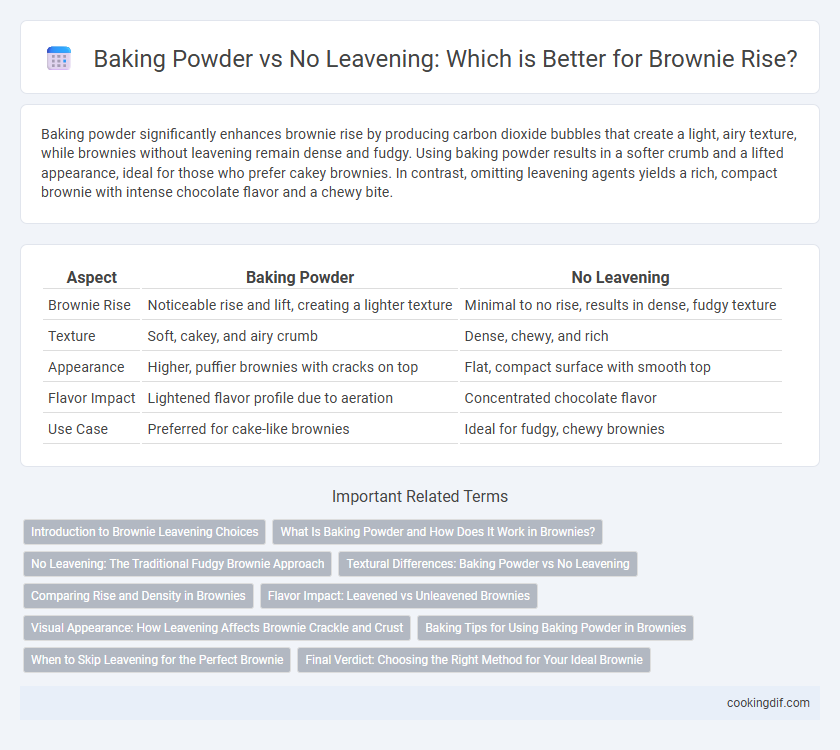Baking powder significantly enhances brownie rise by producing carbon dioxide bubbles that create a light, airy texture, while brownies without leavening remain dense and fudgy. Using baking powder results in a softer crumb and a lifted appearance, ideal for those who prefer cakey brownies. In contrast, omitting leavening agents yields a rich, compact brownie with intense chocolate flavor and a chewy bite.
Table of Comparison
| Aspect | Baking Powder | No Leavening |
|---|---|---|
| Brownie Rise | Noticeable rise and lift, creating a lighter texture | Minimal to no rise, results in dense, fudgy texture |
| Texture | Soft, cakey, and airy crumb | Dense, chewy, and rich |
| Appearance | Higher, puffier brownies with cracks on top | Flat, compact surface with smooth top |
| Flavor Impact | Lightened flavor profile due to aeration | Concentrated chocolate flavor |
| Use Case | Preferred for cake-like brownies | Ideal for fudgy, chewy brownies |
Introduction to Brownie Leavening Choices
Baking powder introduces carbon dioxide gas during baking, causing brownies to rise and develop a lighter, cakey texture, while brownies without leavening remain dense and fudgy. The choice between using baking powder or no leavening influences crumb structure, affecting moisture retention and mouthfeel. Understanding these leavening options is essential for tailoring brownies to preferred texture and richness.
What Is Baking Powder and How Does It Work in Brownies?
Baking powder is a chemical leavening agent consisting of an acid and a base that produces carbon dioxide gas when moistened and heated, causing brownies to rise and develop a lighter texture. In brownies, baking powder creates air pockets that contribute to a fluffier, cakier consistency compared to the dense and fudgy texture of brownies made without leavening agents. Using baking powder can alter the traditional dense nature of brownies, making them more similar to cake in structure and mouthfeel.
No Leavening: The Traditional Fudgy Brownie Approach
No leavening agents like baking powder are omitted in traditional fudgy brownie recipes to achieve a dense, moist texture with a deep chocolate flavor. The absence of leavening ensures minimal rise, resulting in a chewy, rich bite rather than a cake-like crumb. This method emphasizes the use of high-quality cocoa, melted butter, and precise baking times for the classic fudgy consistency.
Textural Differences: Baking Powder vs No Leavening
Baking powder creates a lighter, airier texture in brownies by producing carbon dioxide bubbles during baking, which lift the batter and create a soft crumb. In contrast, brownies made without any leavening tend to have a dense, fudgy texture with a chewier bite. The presence or absence of baking powder directly influences the crumb structure and overall mouthfeel of the finished brownie.
Comparing Rise and Density in Brownies
Baking powder significantly increases brownie rise by releasing carbon dioxide during baking, resulting in a lighter, airier texture compared to brownies made without leavening agents. Without baking powder, brownies tend to be denser and fudgier due to the lack of gas bubbles that create lift in the batter. The choice between using baking powder or not directly affects the crumb structure, with baking powder producing a more porous and soft brownie and no leavening creating a compact, chewy bite.
Flavor Impact: Leavened vs Unleavened Brownies
Baking powder creates a lighter, fluffier brownie texture by introducing air pockets but can slightly dilute the rich, dense chocolate flavor typical of traditional brownies. Unleavened brownies, lacking baking powder, maintain a fudgy, dense consistency that intensifies the deep cocoa taste, preferred by chocolate purists. Choosing leavened or unleavened brownies ultimately impacts the balance between softness and concentrated flavor distinct to homemade or classic brownie recipes.
Visual Appearance: How Leavening Affects Brownie Crackle and Crust
Baking powder creates a light, airy texture that contributes to a pronounced crackle and slightly puffed crust on brownies, enhancing their visual appeal. Brownies made without leavening tend to have a denser, fudgier interior with a flat, glossy surface and minimal crackling. The presence or absence of baking powder directly influences the crust's crispness and the characteristic fissures commonly associated with classic brownie aesthetics.
Baking Tips for Using Baking Powder in Brownies
Using baking powder in brownies enhances their rise by producing carbon dioxide during baking, creating a lighter, airier texture compared to no leavening agents which result in denser, fudgier brownies. For optimal baking results, accurately measure baking powder--typically 1/4 to 1/2 teaspoon per batch--and sift it with the flour to ensure even distribution. Avoid overmixing the batter after adding baking powder to prevent excessive gluten development, maintaining a tender crumb and consistent rise.
When to Skip Leavening for the Perfect Brownie
Skipping leavening agents like baking powder in brownie recipes results in a denser, fudgier texture preferred by many dessert enthusiasts seeking a rich bite. Use baking powder only when aiming for a cakier, lighter brownie with more volume and a tender crumb. Opt to omit leavening when the goal is to highlight intense chocolate flavors and achieve a compact, moist interior characteristic of classic brownies.
Final Verdict: Choosing the Right Method for Your Ideal Brownie
Baking powder enhances brownie rise by introducing a light, airy texture ideal for cakey brownies, while omitting leavening agents produces dense, fudgy results favored by purists. For a balanced approach, incorporating a small amount of baking powder yields noticeable lift without compromising richness, perfect for versatile brownies that suit diverse palates. Selecting the right method depends on desired texture--use baking powder for fluffiness and no leavening for classic fudginess.
Baking Powder vs No Leavening for brownie rise Infographic

 cookingdif.com
cookingdif.com